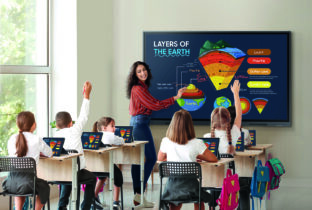Advancements in educational technology bring a host of new possibilities to classroom learning. Tablets and Chromebooks enable students to engage with rich digital curriculum and resources that offer much more than printed textbooks. From videos and interactive activities to online assessments and adaptive learning capabilities, educational technology empowers students to engage with their school lessons like never before.
Teachers clearly see the value of one-to-one technology. According to a 2015 survey conducted by GfK, 91 percent of teachers surveyed felt that success is more easily attained in the classroom by taking advantage of technological options. However, the transition from a traditional to a digital curriculum can be challenging. As with any change to educational practices, professional development and easy access to teaching resources is key to ensuring a successful transition.
Give Teachers Time to Play
Before deploying new digital curriculum for students, take the time to familiarize your teachers with these resources, including training on how to most effectively integrate them into lessons. Encourage faculty members to explore the videos and other educational assets, and even take part in the the interactive activities that their students will be completing. This firsthand experience will help them understand how the activities and videos come together in a lesson.
Encourage department-level groups to work together to decide the order in which to present lessons and which digital materials best support them. Intradepartment groups can work to ensure that they’re including cross-curricular assignments, when appropriate. You might also want to schedule school-wide group sessions for teachers to share what they’ve discovered and to brainstorm ways to use the new curriculum with students. Additionally, encourage informal sessions where teachers ask each other questions and discuss how to solve technology problems on the fly.
Be Available to Hear Feedback
Some teachers will immediately see the benefits and possibilities of technology-based curriculum tools, and they’ll figure out how to integrate them. Meanwhile, others will need help to use these new digital curriculum tools. According to the 2015 GfK survey, 63 percent of teachers felt they need additional technology training in order to support their students’ needs.
Administrators have the opportunity to listen to their teachers’ questions and concerns, which can aid in adoption of these new tools. Ensure that your digital curriculum solution includes as many professional development resources as possible to provide the resources needed by both excited and hesitant teachers.
Train Teachers Fully on Management Tools
Resources in a technology-based curriculum often require a greater level of teacher management than traditional textbooks. Classroom management tools allow teachers to enable or restrict specific apps or digital curriculum resources. They can also allow teachers to monitor activity on tablets or Chromebooks to ensure students stay on task. In order to effectively manage a technology-based classroom, teachers will need to be fully comfortable using the technology that allows them to control access to the materials.
A Classroom in a Box
Recognizing the challenges of transitioning to one-to-one computing, Samsung has partnered with McGraw-Hill Education to create the Classroom in a Box solution. Classroom in a Box combines all the key elements needed for a successful pilot, including tablets or Chromebooks, proven digital curriculum from McGraw-Hill, professional development services and licenses to Google’s web-based console to enable easy management of all student devices. The aim is to make it easy for school districts to make the leap to digital curriculum.
Allow for Change
One of the really exciting changes made possible by electronic curriculum resources is a move toward a more interactive classroom. Though the move to a digital curriculum may be challenging, it is well worth the effort. Not only does it allow students to interact more deeply with the material, it also can lead to significant changes in the pedagogy, such as more project-based, flipped or blended learning.







